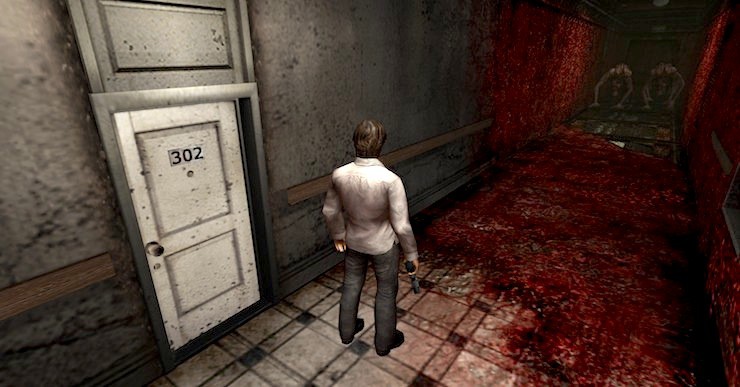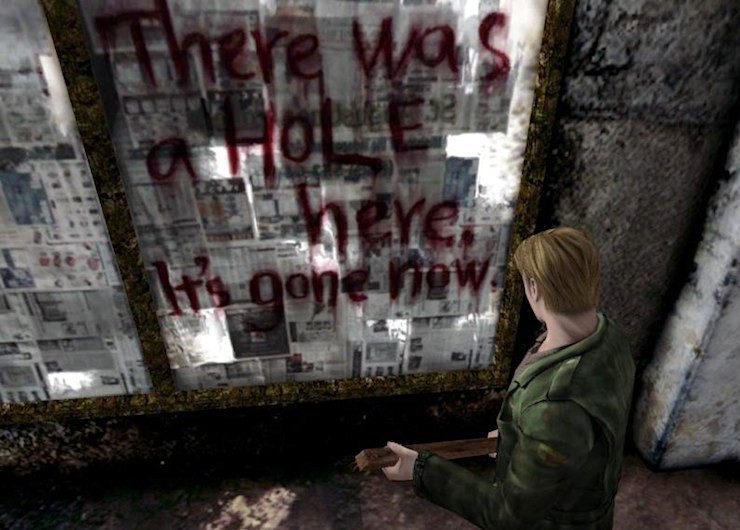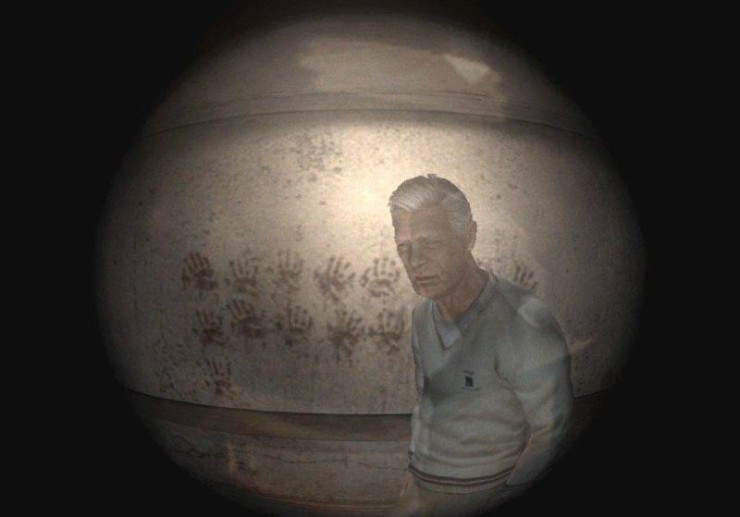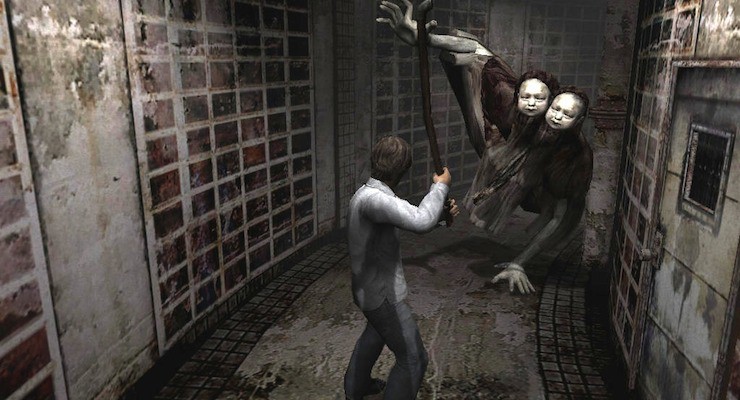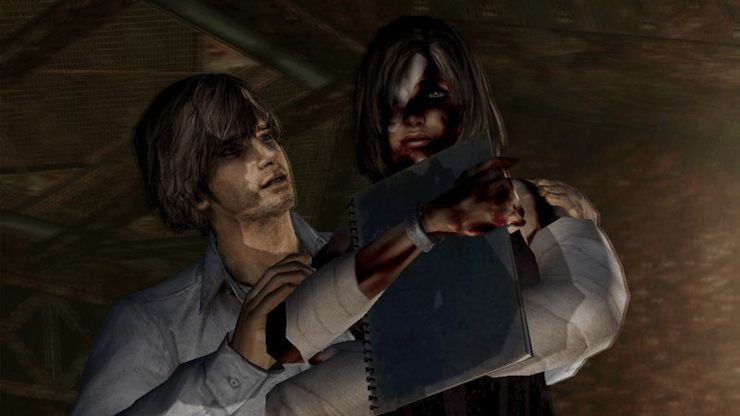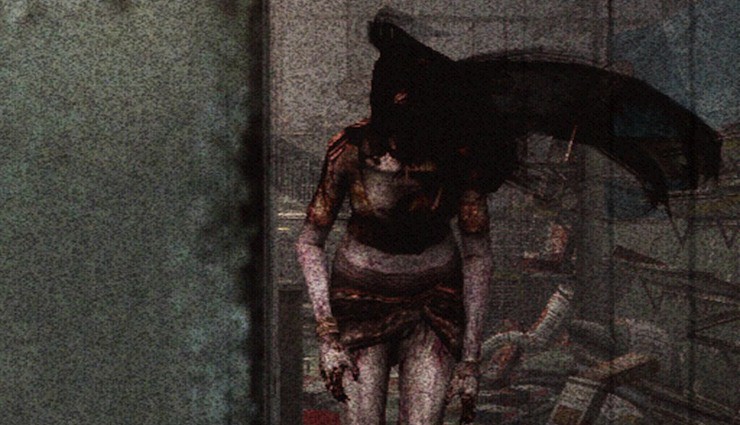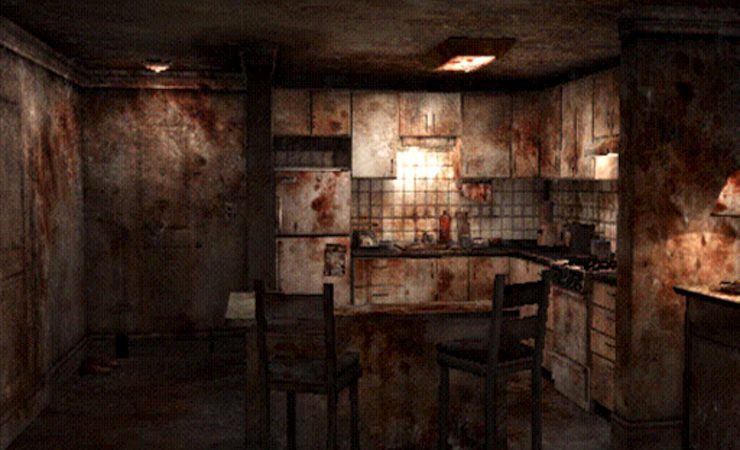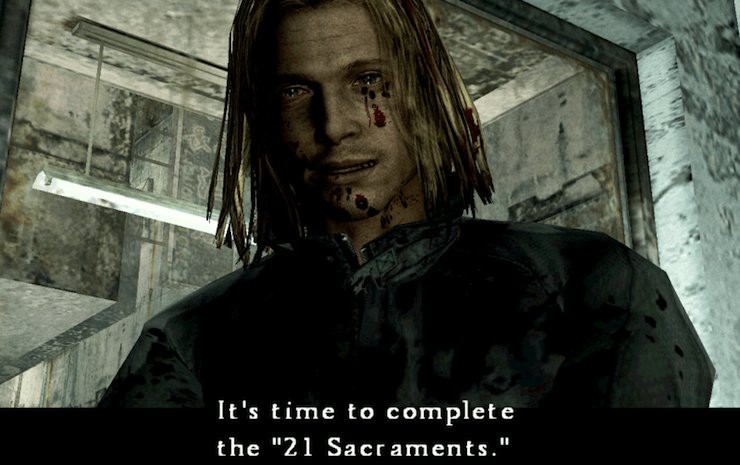Silent Hill 4: The Room—released in 2004 for PlayStation 2 and the Xbox—is the best Silent Hill game after the second one and one of the most original horror games ever developed. If SH4 hadn’t been part of the Silent Hill series, it’d probably be considered one of the most unique games in the genre. Part of what makes it so distinct is that it goes against the formula of what we’d come to expect of the series. Many gamers, including myself, were initially turned off by how drastically it had changed. But once the expectations faded, a horrifying experience awaited, unrelenting in its oppressive terror.
Room 302
A big part of why most of the recent Silent Hill games have been underwhelming is because they tried to outdo what was essentially narrative perfection in Silent Hill 2. The story is a trek through madness, guilt, and personal horror projected subconsciously into some of the most gruesome monsters ever seen. The climax is both revolting and satisfying, a narrative twist that makes the jigsaw puzzle of Sunderland’s journey a Rosetta Stone of death.
As much as I enjoyed parts of Homecoming, Downpour, SH3, and Origins, they felt more or less the same games, only rehashed. In short, protagonist has issues in Silent Hill, an evil cult causes a whole lot of trouble, and we wish we’d never entered the hellishly foggy suburbia. Revelations uncover a dark past that can be resolved in a number of different ways. Awesome sound effects and music from Akira Yamaoka (and Daniel Licht for Downpour and Memories) scare the crap out of us. Occasionally, a UFO reveals its grand machination to take over the world. Rinse and repeat.
SH4 began as a side story with loose connections to the series before becoming a full-fledged sequel. Because of its tangential origins, Team Silent was able to experiment and innovate on some of the core ideas in the series, sometimes scrapping them altogether. The Room’s biggest achievement is that it makes mundane, every day living, horrifying. At least with the previous three Silent Hill games, I felt like I was transported to a place that was far away, a slice of American life seen through the prism of Japanese developers.
SH4 brought the terror home. Henry Townshend is stuck inside of his own apartment and can’t leave. To highlight the feeling of familiarity, all the sequences in the apartment are in first person mode. It’s you who’s chained in and taken captive with no explicable reason. A claustrophobic atmosphere pervades and in the tight space you call your apartment, there’s no food, the phone is disconnected, and the television is shut off. It also didn’t help that the first time I played SH4, I lived in an Apt. #304, just two doors away from the game’s Room 302.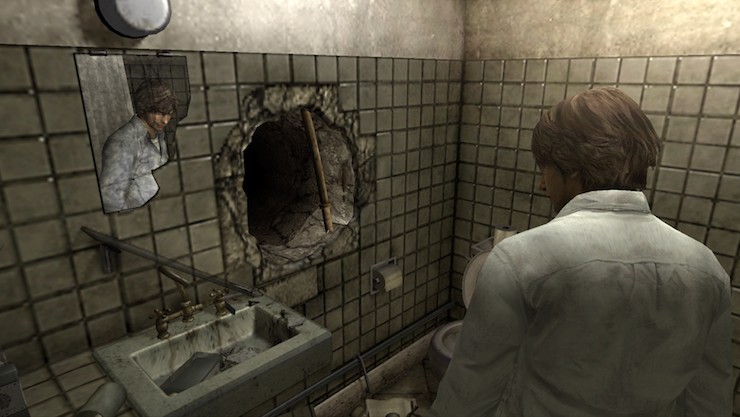
The voyeurism of spying on your neighbor and the people across from you, a la Hitchcock’s Rear Window, is both creepy and addicting. You can look out the window and see people going about their lives, all of them oblivious to what you’re going through. One of the most disturbing interactions I had didn’t even revert to the typical scare tactics most games use—you know, gory monsters and agonizing shrieks punctuated by alarming music. Rather, it takes place mostly in “silence.”
Alerted by neighbors, the superintendent checks up on your room, knocking on the front door, even using the spare key to try to enter. He is unable to get past the chains and despite your pleas for help, he can’t hear a thing. He eventually writes you a note and slips it under the door. When you look at it, it’s covered in blood, undecipherable. The superintendent then murmurs how reminiscent this is of the last time, and I’m thinking, what last time and what in the world happened to the slip? For the next few peeps out your front door, you’ll see him standing in the hallway, troubled, unable to articulate his fears. Just by staring at his troubled, polygonal face, powerless to help yet knowing what awaited me, I felt terror. Not only was aid from the outside world going to be impossible, but the dude outside pretty much knew I was screwed.
The game’s protagonist, Henry Townshend, is bland and generic. He has no connection to the villain, no demons that need exorcising. Unlike the previous Silent Hills, the monsters aren’t projections of the hero’s subconscious fears and guilts. It might seem like a major negative, but Henry is designed as a projection of the gamer, a blank avatar that just happens to be in the wrong place at the wrong time. By trade, he’s a photographer, which is the perfect profession for a main character whose principal purpose is to observe and understand. At times, the voyeurism verges on the perverse, and it’s an odd way of embodying the sacrament of “wisdom.” His journey through the womb-like tunnels signify a ghastly rebirth. What’s most fascinating is the void in Townshend’s personality allows the main arc to center around the serial killer, Walter Sullivan, whose nightmarish wonderland we’re sucked into via the toilet hole from hell. Each of his victims populates these ghoulish bubble worlds, encapsulated and scarred by Silent Hill’s signature cult, The Order. The deadliest of these worlds is the Water Prison and a great example of what makes SH4 so good.
The Water Prison
A panopticon is conceptually one of the most efficient prison systems conceivable. A single watchman sits in the middle of a circular prison and observes all the cells around him. The inspection house has a one-way mirror into each room so that none of the prisoners know who is being watched at any given moment. It’s intended to produce paranoia, insecurity, and dread.
SH4’s Water Prison is a panopticon used by the Order to control the orphans it had under its care. It’s also a symbolic projection of Sullivan and his relationship to his victims, all of whom he is keeping tabs on. Sullivan was tortured here as a child, and his friend, Bob, disappeared at the hands of Andrew DeSalvo, a guard in the prison. As Townshend navigates the arcane spirals of the tower, he begins to understand the inhuman events that took place there. Most of these revelations come from notes he uncovers, some nonchalantly describing gruesome acts, others from orphans who are going mad. From the bloody beds and the holes built to efficiently dispose of corpses, to the brutal torture hall in the basement, this branch of the Silent Hill Smile Support Society was anything but a happy place for its inhabitants.
The first visit to the prison is relatively harmless. There are very few foes, though the Twin Victim monsters make their debut here as the conjoined reincarnation of Sullivan’s 7th and 8th victim (their baby faces clash in innocence and agony, making for a ghoulish coupling). The puzzles aren’t very difficult either (spinning the tower floors to line up the death pits). But it’s the way the story is so integrated into the architecture that makes this part so unnerving. Up until then, many of the creepiest settings in the SH games were rusted, industrial versions of their counterparts in the light world. They were scary, but more because they looked like hell factories enshrouded in night, decay, and headless mannequins. In SH4, the Water Prison isn’t set in a dark, twisted parallel universe, but is based on reality. Children were being tortured there in the most horrendous ways. The scariest part is that it feels like a believable place, grounded in the history of actual prison sites (the whole idea of a panopticon was philosopher Jeremy Bentham’s way of trying to devise a jail system that was more cost-effective). Human behavior at its worst is incomparably more diabolical than monsters at their most villainous. The atmosphere exudes with palpable suffering, giving us intimations of the tragedy of Sullivan’s past.
The whole prison has the psychological effect in turning the tables against DeSalvo. Rather than the pity or sympathy we feel when we first see him begging for his life outside his prison door, he begins to elicit disgust. Sullivan, the serial killer, actually becomes a sympathetic figure. When DeSalvo is found dead in the torture room, I’m willing to bet few gamers shed tears. It’s a labyrinthine allegory of Sullivan’s mind that’s making our own judgement just as murky. You literally need to shine a light all the way to the depths to complete the sequence.
19/21
The second half of the game has received a lot of criticism and is the biggest reason the game is maligned by fans. In part, it’s because you have to revisit all the levels while escorting Eileen, who has arguably some of the worst AI in gaming. But it’s also because the difficulty level makes a sudden spike into almost nauseating painfulness. Towing the line between being frustrating and challenging is one of the toughest balancing acts designers face.
I thought Team Silent did a great job in inducing a sense of helplessness, a motif that permeates the game. I haven’t felt this vulnerable in a Silent Hill game, or any other horror game outside of Amnesia, since. You sprint from one area to the next, Eileen limping next to you. She is not only easy prey for the enemies, but you can damage her as well. At times, this can be trying, especially since you’re unable to permanently ward off the invincible ghosts without one of the rare swords. But it also forces you to plan out your approach and get a good sense of the layout.
While the levels are recycled, each of them has new camera angles, making them feel like different locations. The unsettling perspective often precludes your front view, making the sudden appearance of monsters startling. The worlds are connected by stairs that are somewhat like the umbilical cord tying the tragedy together, and the maddening cohesion gives you a deeper appreciation for the geographical manifestation of Sullivan’s tattered psyche. In many of the other Silent Hill games, the best tactic is to run away from enemies, sprinting through the danger zones without really being able to soak them in. That isn’t the case with SH4.
In the second visit to the Building World, there’s a pet store where a brutal massacre took place. The first time through, I pretty much forgot it. The second time though, three ghosts ambush you between the shelves and the changing camera angles make it feel like the store itself is trying to kill you. When you uncover its dark past through newspapers on the ground and you hear the echoes of the bullets that destroyed it, it all clicks. Sullivan’s mind isn’t just channeling his own suffering, but those around him as well.
Personalization is an important aspect of the game. The most difficult ghosts you face are the people you saw get killed by Sullivan earlier, giving you a morbid sense of connection to them. I was still wracked by guilt that I hadn’t been able to save one of the victims, Cynthia, in the subway station. Later, she unleashes a Bayonetta styled hair attack that sucks you dry as she pursues you from one train to the other. I hated their presence, but at the same time, understood why they were so raving mad in the afterlife.
Eileen’s mental states begins to deteriorate as she gets hurt by all the ghosts. But what’s more interesting is that she can’t be killed. Usually, escort missions are so annoying because your companions need constant rescuing before they die. In SH4, her damage level only impacts the ending you’ll get. You can completely neglect her, or take pains to prevent her from taking any hits. She’s another layer in the psychological Rorschach of your gameplay and her state is a reflection of your own attitude towards her. It also mirrors Walter’s relationship with his parents, a disturbing thread to say the least.
You can’t ever let your guard down as SH4 will leave you breathless, panicked, and anxious.
A maniacal Walter Sullivan only exacerbates the situation, taunting you with a chainsaw throughout the levels, impervious to your attacks. At least you can tunnel your way back and find solace in your apartment…
Actually, scrap that. Your apartment becomes haunted. The disintegration happens at a slow crawl and ends in a torturous avalanche. Your room no longer heals you and will at times drain your energy. Windows shake, a blood-drenched apparition of yourself appears in your peephole, a ghost tries to break into your apartment, Robbie the Rabbit is staring at you with blood on his cheeks, and angry doll babies haunt your item box (damn you Sullivan for giving me that Shabby Doll!). There is no haven, no escape. The terror becomes ubiquitous.
21 Sacraments
I’ll admit, when I first started The Room, I had lots of reservations. I was confused the game had strayed so far from the best in the series. Even the character models did not seem as haunting or graphically visceral as the ones in the first three. Silent Hill 2 was not only one of my favorite horror games, but one of the best gaming experiences I’d ever had. In fact, about a decade ago, one of the main reasons I decided to leave LucasArts for EA was so I could work with the art director and principal designer of Silent Hill 2, Sato Takayoshi, who had left Konami after SH2. Here was the man who’d taken what might be considered the drawbacks of the uncanny valley and made it into a distinctive style. His attention to detail was inspiring and his insights into the mythos of Silent Hill 2, as well as game design in general, helped me to understand gaming in a very different light. I didn’t think SH2 could ever be topped.
The moment my perspective on that changed was when I was in my real living room (#304, remember) after playing The Room. It was late and I heard my neighbors talking right outside my apartment door. I got creeped out and checked the peephole. I didn’t recognize them. Who were they? What were they talking about? Were they conspiring against me? I was mixing up the horror of SH4’s eponymous room with my own in real life.
I began to appreciate the game for its own merits rather than wondering why it wasn’t another retread of James Sunderland and Heather Mason’s journey. As I looked at all the elements in play, from the grim radio broadcasts, to the needling sound whenever a ghost approaches, to the seemingly interminable escalator ride in the train station, and the panoply of surreal hospital rooms, I realized SH4 paid tribute to the series without being bound by it. There were genuine terrors that had me sweating with fear. Not even Silent Hill 2 had me terrified of my own apartment. And while Sunderland’s personal revelation at the end of SH2 is one of the most shocking twists in gaming, SH4’s surprise “room” is pretty damn appalling too, capturing both the madness of Sullivan, as well as the insane extent to which he’ll go to be with his mother again.
With the news that P.T./Silent Hills is canceled, or at least put on hold, I’ve wondered what direction the series will go if it ever picks back up. A big reason people were so thrilled by P.T. was because it changed the formula so much, even incorporating aspects that many gamers felt were reminiscent of SH4. If the Silent Hill series ever does come back from the dead, I hope they’ll follow in the spirit of The Room, innovating and trying out new ways to terrify gamers instead of clinging to the previous tenets of the Silent Hill formula like they were sacrosanct. Until then, you’ll find me sleeping with all the lights on, wondering what the strange noises coming from my bathroom are.
Originally published in October 2015
 Peter Tieryas is the author of Mecha Samurai Empire and United States of Japan, which won Japan’s top SF award, the Seiun. He’s written for Kotaku, S-F Magazine, Tor.com, and ZYZZYVA. He’s also been a technical writer for LucasArts, a VFX artist at Sony, and currently works in feature animation. He tweets @TieryasXu.
Peter Tieryas is the author of Mecha Samurai Empire and United States of Japan, which won Japan’s top SF award, the Seiun. He’s written for Kotaku, S-F Magazine, Tor.com, and ZYZZYVA. He’s also been a technical writer for LucasArts, a VFX artist at Sony, and currently works in feature animation. He tweets @TieryasXu.










